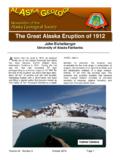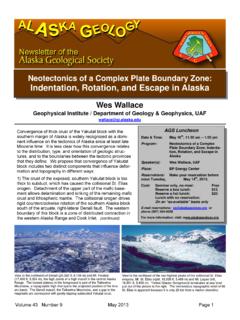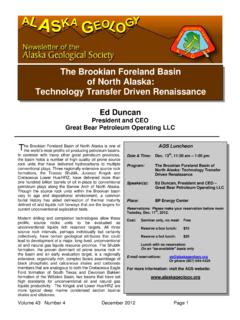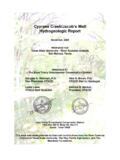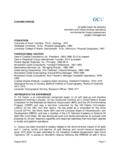Transcription of 4D Seismic at Alpine Field, Alaska and ... - Alaska …
1 Volume 44 Number 4 December 2013 Page 1 4D Seismic at Alpine field , Alaska and Time-lapse 3D/4D Observations at Simpson Lagoon, Milne Point, Alaska Leo T. Brown ConocoPhillips Alaska , Inc., Anchorage, AK Alpine The Alpine field on the Alaskan North Slope has been produced with a WAG (water alternating miscible gas) EOR process since startup in 2000 and is about halfway to its expected ultimate recovery. The first 3D Seismic data set over the field was acquired in 1996. A new 3-D Seismic dataset was acquired in 2010 for improved reservoir characterization and to monitor reservoir changes due to production.
2 To help justify the 2010 survey, a time-lapse feasibility study was carried out that predicted the magnitude of the 4D signal from the Alpine reservoir. Well-based (1-D) scenario modeling and Sim2 Seis reservoir simulator-based (3D) modeling were carried out for changes in elastic parameters and in upscaled Seismic response. The core rock physics model had two main components: Gassmann fluid substitution for saturation changes and a pressure model calibrated to ultrasonic measurements on core. The Seismic synthetic modeling utilized wavelet bandwidth and S/N levels from experience with land acquisition at nearby fields.
3 4D signal modeling showed the expected MWAG signature to be present but subtle with respect to the expected 4D NRMS (noise) levels of 20-30%. (continued) AGS Luncheon Date & Time: Dec. 12th, 11:30 am 1:00 pm Program: 4D Seismic at Alpine field , Alaska and Time-lapse 3D/4D Observations at Simpson Lagoon, Milne Point Alaska Speaker: Leo Brown, ConocoPhillips Alaska , Inc. and Daniel Yancey, BP Exploration, Ltd. Place: BP Energy Center Reservations: Make your reservation before noon Tuesday, Dec 10th, 2013 Cost: Seminar only, no meal: Free Reserve a box lunch: $15 Lunch with no reservation: On an as-available basis only Daniel Yancey BP Exploration, Ltd.
4 , Anchorage, AK Volume 44 Number 4 December 2013 Page 2 About the Speakers: Leo Brown is a staff geophysicist at ConocoPhillips Alaska currently working Western North Slope Development. He has held exploration and rock physicist positions in Norway and Houston with ConocoPhillips and worked as an engi-neering geophysicist for Geovision Geophysical Services Company. He holds a BS in Geology from Brigham Young University, MS in Geotechnical Engineering from University of Texas at Austin, and MS in Geophysics from Colorado School of Mines Daniel Yancey began his career with BP Alaska in 2005 after earning a and in geophysics from Virginia Tech.
5 He has done geophysical work for most reservoirs operated by BP on the North Slope. Additionally, he has worked the sub-salt Paleogene section in the Gulf of Mexico Exploration Team for BP in Houston, Texas. He is cur-rently one of the geophysicists working on the Milne Point field . The 2010 monitor survey was acquired for the best 3D image at the expense of 4D repeatability. Acquisition differences were partially overcome by dedicated 4D parallel processing of base and monitor surveys, but the resulting 4D NRMS levels are high ~40%.
6 Despite the non-ideal nature of the 4D experiment, the 4D differ-ence data shows a clear signal (rock softening) aligned with current injectors. The 4D observations suggest a much larger response than that can be observed solely from a combination of pressure and fluid response on the rock. The 4D Seismic signal is consistent with the opening of fractures in the reservoir zone due to high water pres-sure injection. A fractured rock physics model has been incorporated in the Sim2 Seis workflow. Incorporating fractures in the Seismic modeling has allowed matching of the synthetic with 4D Seismic field data.
7 Ongoing efforts are focused on calibration and understanding of the fracture phenomena. An understanding of the 4D signal is necessary to correctly interpret the changes in fluid saturation and opti-mize recovery, to assign a more accurate monetary value to 4D Seismic , and to best plan the timing of repeat survey acquisition. The inclusion of fracturing in the 4D Seismic modeling workflow is new and can also help explain why 4D velocity decreases around injector wells are often observed to be larger than expected. Milne Point The Milne Point field is 100% owned and operated by BP Alaska .
8 During mapping of the Kuparuk section in the early 2000s, amplitude blooms located around injectors were noticed on an OBC survey that was shot in 2001 that were not present on a previous dataset shot before field start-up. From this, many new drilling loca-tions were identified and the data have been used in a qualitative sense to aid in identifying new drilling loca-tions. BP recently acquired another OBC survey in the summer of 2012 over the same area. This talk will focus on the uses and qualitative observations of the 2001 data and the current plans around a 4D processing project utilizing the 2001 and 2012 datasets.
9 From the President s Desk: Last month I had the opportunity to discuss the role of the Alaska Geological Society in regards to community involve-ment. Aaron Rowbotham, a geological science major at the University of Alaska Anchorage, was working on a profile paper of the AGS for an English class and had asked for an interview. This sent me scrambling to the AGS website to brush up on our charter and by-laws to see exactly what statements we ve made regarding community involvement. The documents each have articles stating our purpose, parts of which seem to be specifically directed at professional geologists.
10 However, both documents do have essentially the same simple statement, to promote an interest and under-standing of Alaska geology and related earth sciences. With no specific group identified I took this to mean the promo-tion could take place in the general community. Although I had little doubt I was glad to see our legal documents didn t make us out to be a clubby, insular group of stuffy professionals. In practice our community involvement is mainly through educational funding and support of educational activities. Mr. Rowbotham s paper aptly reflected this and many other aspects of the AGS.


